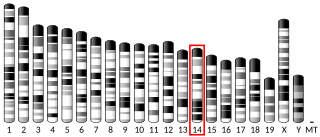
Pericentriolar material 1, also known as PCM1, is a protein which in humans is encoded by the PCM1 gene.

Ninein is a protein that in humans is encoded by the NIN gene.

Centrosomal protein of 290 kDa is a protein that in humans is encoded by the CEP290 gene. CEP290 is located on the Q arm of chromosome 12.

Pericentrin (kendrin), also known as PCNT and pericentrin-B (PCNTB), is a protein which in humans is encoded by the PCNT gene on chromosome 21. This protein localizes to the centrosome and recruits proteins to the pericentriolar matrix (PCM) to ensure proper centrosome and mitotic spindle formation, and thus, uninterrupted cell cycle progression. This gene is implicated in many diseases and disorders, including congenital disorders such as microcephalic osteodysplastic primordial dwarfism type II (MOPDII) and Seckel syndrome.

Centrosome-associated protein 350 is a protein that in humans is encoded by the CEP350 gene.

Progesterone-induced-blocking factor 1 is a protein that in humans is encoded by the PIBF1 gene. It has been shown to localize to the centrosome and has also been named CEP90.

Putative RNA-binding protein Luc7-like 2 is a protein that in humans is encoded by the LUC7L2 gene.

Centrosome-associated protein CEP250 is a protein that in humans is encoded by the CEP250 gene. This gene encodes a core centrosomal protein required for centriole-centriole cohesion during interphase of the cell cycle. The encoded protein dissociates from the centrosomes when parental centrioles separate at the beginning of mitosis. The protein associates with and is phosphorylated by NIMA-related kinase 2, which is also associated with the centrosome. Furthermore, CEP135 is also required for the centriolar localization of CEP250.

U3 small nucleolar RNA-associated protein 14 homolog A is a protein that in humans is encoded by the UTP14A gene.

Centrosomal protein 170kDa, also known as CEP170, is a protein that in humans is encoded by the CEP170 gene.

Centrosomal protein of 68 kDa is a protein that in humans is encoded by the CEP68 gene. CEP68 is required for centrosome cohesion. It decorates fibres emanating from the proximal ends of centrioles. During mitosis, CEP68 dissociates from centrosomes. CEP68 and rootletin depend both on each other for centriole association, and both also require CEP250 for their function.

Centrosomal protein of 57 kDa is a protein that in humans is encoded by the CEP57 gene. It is also known as translokin.

Centriolar coiled-coil protein of 110 kDa also known as centrosomal protein of 110 kDa or CP110 is a protein that in humans is encoded by the CCP110 gene. It is a cell cycle-dependent CDK substrate and regulates centrosome duplication. CP110 suppresses a cilia assembly program.

Centrosomal protein of 72 kDa is a protein that in humans is encoded by the CEP72 gene.

Centrosomal protein of 135 kDa is a protein that in humans is encoded by the CEP135 gene. It is part of the centrosome throughout the cell cycle, being distributed in the pericentriolar material. CEP135 is required for the centriolar localization of CEP250.

Rootletin also known as ciliary rootlet coiled-coil protein (CROCC) is a protein that in humans is encoded by the CROCC gene. Rootletin is a component of the ciliary rootlet, and, together with CEP68 and CEP250, is required for centrosome cohesion.

Centrosomal protein of 192 kDa, also known as Cep192, is a protein that in humans is encoded by the CEP192 gene. It is the homolog of the C. elegans and D. melanogaster gene SPD-2.

Centrosomal protein of 164 kDa, also known as CEP164, is a protein that in humans is encoded by the CEP164 gene. Its function appears two be twofold: CEP164 is required for primary cilium formation. Furthermore, it is an important component in the response to DNA damage by UV light.

Centrosomal protein of 76 kDa, also known as CEP76, is a protein that in humans is encoded by the CEP76 gene.

Centrosomal protein of 152 kDa, also known as Cep152, is a protein that in humans is encoded by the CEP152 gene. It is the ortholog of the Drosophila melanogaster gene asterless (asl) and both are required for centriole duplication.





















